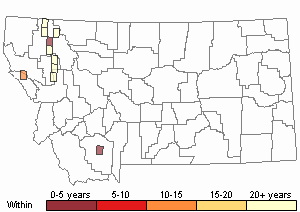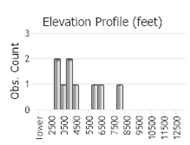View in other NatureServe Network Field Guides
NatureServe
Montana
Utah
Wyoming
Idaho
Wisconsin
British Columbia
South Carolina
Yukon
California
New York
Pleasing Wing Moss - Plagiothecium laetum
General Description
Plants: Pleurocarpous, growing in dense (FNA 2014) or slender mats (Crum and Anderson et al. 1981), pale green (FNA 2014) to brilliant green, green with yellow tones, or golden (Crum and Anderson et al. 1981), shiny. Stems creeping, to 20 mm, typically with leaves strongly flattened into one plane, or seldom appressed and overlapping, giving the stem a catkin-like appearance; pseudoparaphyllia wanting (FNA 2014).
Leaves: Overlapping or seldom remotely spaced, similar in wet and dry conditions, upright or spreading, occasionally noticeably turned to one side with tips directed toward the substratum, not symmetrical, not pleated, the blade plane or frequently a little wavy, to 2.6 mm in length and to 1.2 mm in width, egg-shaped and somewhat oblong to lance-shaped with ovate tendencies, gradually narrowing to the slender acumen; base extending down the stem, the decurrencies triangular (FNA 2014), but occasionally bulging or ear-like (Crum and Anderson et al. 1981); leaf edges flat or frequently a slender portion curved back and downward for much of the leaf length (not quite to the apex), smooth or occasionally with a few fine saw-teeth at the leaf tip; costa paired, scarcely exceeding the leaf bottom, with one division seldom reaching about halfway up the leaf, or costa absent. Branch leaves akin to stem leaves (FNA 2014).
Leaf Cells: Cells of the lamina smooth; basal cells of the lamina with walls pitted (Lawton 1971), wider and not as long as the medial cells; medial cells linear or linear and very narrowly diamond-shaped, sometimes slightly bent, usually longer than the apical cells, containing a lot of chlorophyll; alar cells oblong, arranged in up to 5 longitudinal rows and ending in a single cell at the bottom (FNA 2014).
Phenology
Fruit ripens in summer (FNA 2014).
Diagnostic Characteristics
Plagiothecium laetum is generally smaller than the similar Plagiothecium denticulatum. P. denticulatum has leaves from 1.5-4 mm in length rather than 0.7-2.6 mm, wider medial cells, decurrencies often oval in shape and usually containing some oval-shaped cells rather than decurrencies deltoid with oblong cells, and capsules ridged rather than smooth when dry (FNA 2014).
Range Comments
North American Range
Canada: YT to NU, BC to NL and NS; USA: AK, WA to CA, ID, MT, CO, NM, MN, IA, WI, MI, most states ne of and inclusive of OH to VA, also TN and NC (FNA 2014). Known in Montana from Flathead, Glacier, Lake, Missoula, and Sanders Counties (Elliott and Pipp 2016).
Observations in Montana Natural Heritage Program Database
Number of Observations: 31
(Click on the following maps and charts to see full sized version)
Map Help and Descriptions
Relative Density

Recency



 (Observations spanning multiple months or years are excluded from time charts)
(Observations spanning multiple months or years are excluded from time charts)
Habitat
Typically in evergreen woods, frequently in somewhat dry places, often on precipitous banks, not as frequent on tree bottoms, decaying wood, or soil and humus on top of boulders and shelves of bluffs (Crum and Anderson et al. 1981). Occurring from lowlands to 10,170 feet elevation (FNA 2014), most often above 2300 feet (Lawton 1971).
Reproductive Characteristics
Autoicous, typically producing sporophytes. Perigonia and perichaetia numerous at stem bottoms. Seta 10-16 mm tall, spiraled, smooth, somewhat brown or sometimes red. Capsule upright to nodding, bowed or not, in a range of brown shades when well-developed, to 2 mm in length (FNA 2014), not shrunken below the opening when dry (Crum and Anderson et al. 1981), smooth, or the neck seldom creased in bowed forms; operculum to 0.8 mm, cone-shaped or with a short beak; exostome teeth with fine, transverse ridges below on the outer surface and papillae above; endostome processes keeled; cilia 1 or grouped in 2s or 3s, occasionally lacking (FNA 2014), knobby (Crum and Anderson et al. 1981). Calyptra draping hood-like, hairless, falling away easily (FNA 2014).
Specialized vegetative reproduction via 3- to 6-celled gemmae at the leaf junctures, typically present (FNA 2014).
References
- Literature Cited AboveLegend:
 View Online Publication
View Online Publication Crum, H.A. and L.E. Anderson. 1981. Mosses of Eastern North America. 2 volumes. Columbia University Press, New York. 1328 pp.
Crum, H.A. and L.E. Anderson. 1981. Mosses of Eastern North America. 2 volumes. Columbia University Press, New York. 1328 pp. Elliott, J.C. and A.K. Pipp. 2018. A Checklist of Montana Mosses (1880-2018). Updated 3 January, 2020. Montana Natural Heritage Program, Helena, Montana. 73 pp.
Elliott, J.C. and A.K. Pipp. 2018. A Checklist of Montana Mosses (1880-2018). Updated 3 January, 2020. Montana Natural Heritage Program, Helena, Montana. 73 pp. Flora of North America Editorial Committee, eds. 2014. Flora of North America North of Mexico. Volume 28. Bryophytes: Mosses, Part 2. Oxford University Press, Inc., NY. xxi + 702 pp.
Flora of North America Editorial Committee, eds. 2014. Flora of North America North of Mexico. Volume 28. Bryophytes: Mosses, Part 2. Oxford University Press, Inc., NY. xxi + 702 pp. Lawton, E. 1971. Moss Flora of the Pacific Northwest. Hattori Botanical Laboratory. Japan: Yamabuki-cho, Shinjuku-ku, Tokyo. 362 pages plus appendices.
Lawton, E. 1971. Moss Flora of the Pacific Northwest. Hattori Botanical Laboratory. Japan: Yamabuki-cho, Shinjuku-ku, Tokyo. 362 pages plus appendices.
- Additional ReferencesLegend:
 View Online Publication
View Online Publication
Do you know of a citation we're missing? Elliot, J. C. 1993. Second checklist of Montana mosses. Unpublished report. U.S. Forest Service, Region 1. Missoula, MT. 45 pp.
Elliot, J. C. 1993. Second checklist of Montana mosses. Unpublished report. U.S. Forest Service, Region 1. Missoula, MT. 45 pp. Lawton, E. 1971. Keys for the Identification of the Mosses on the Pacific Northwest. Reprinted from 'Moss Flora of the Pacific Northwest'. Published as Supplement No. 2 of the Journal of the Hattori Botanical Laboratory. Nichinan, Miyazaki, Japan. 66 pp.
Lawton, E. 1971. Keys for the Identification of the Mosses on the Pacific Northwest. Reprinted from 'Moss Flora of the Pacific Northwest'. Published as Supplement No. 2 of the Journal of the Hattori Botanical Laboratory. Nichinan, Miyazaki, Japan. 66 pp. Malcolm, B., N. Malcolm, J. Shevock, and D. Norris. 2009. California Mosses. Nelson, New Zealand: Micro-Optics Press. 430 pp.
Malcolm, B., N. Malcolm, J. Shevock, and D. Norris. 2009. California Mosses. Nelson, New Zealand: Micro-Optics Press. 430 pp. Smith, A.J.E. 1980. The Moss Flora of Britain and Ireland. Cambridge University Press, Cambridge. 705 pp.
Smith, A.J.E. 1980. The Moss Flora of Britain and Ireland. Cambridge University Press, Cambridge. 705 pp. Vitt, D. J. Marsh, and R. Bovey. 1988. Mosses, Lichens & Ferns of Northwest North America. Seattle, WA: University of Washington Press. 296 p.
Vitt, D. J. Marsh, and R. Bovey. 1988. Mosses, Lichens & Ferns of Northwest North America. Seattle, WA: University of Washington Press. 296 p.
- Web Search Engines for Articles on "Pleasing Wing Moss"





